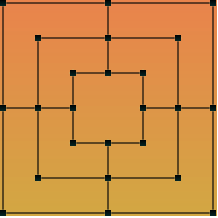
Nine Men Morris
 |
 |
 |
| Home | Index | Links |
 |
Nine Men Morris |
|
| |

|
The game begins with an empty board. The players determine who plays first, then take turns placing their men one per play on empty points. If a player is able to place three of his pieces in a straight line, vertically or horizontally, he has formed a mill and may remove one of his opponent's pieces from the board and the game. Any piece can be chosen for the removal, but a piece not in an opponent's mill must be selected, if possible. |
|
|
Twelve Men's Morris adds four diagonal lines to the board and gives each player twelve pieces. This means the board can be filled in the placement stage; if this happens the game is a draw. This variation on the game is popular amongst rural youth in South Africa where it is known as Morabaraba and is now recognized as a sport in that country |
| Mobile |